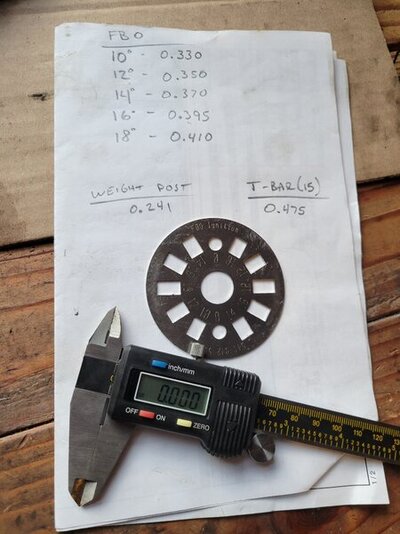Agent_Orange
Well-Known Member
Has to be crank, 16* at the distributor would be a larger slot than the t-bar.I am not sure if the numbers on the FBO plates are dist degrees or crank. I never use them.
Has to be crank, 16* at the distributor would be a larger slot than the t-bar.I am not sure if the numbers on the FBO plates are dist degrees or crank. I never use them.
Maybe try calling FBO. He might be able to clear things up.one more observation:
Halifax got me thinking, my tbar is a 15, so 30* at the crank. I wanted 16* at the crank, so roughly half the slot. The picture below has the 16* slots under the tbar. The inside of both pieces are flush, the fbo plate should restrict the travel by more than it does.
my micrometer needs a new battery, so I wasn't able to get slot readings last night
View attachment 1716141203
I think that is their phone number etched in the plate.Yup, that sounds more like the right concept. Thank you. Looks relatively close here.
View attachment 1716141208
one more observation:
Halifax got me thinking, my tbar is a 15, so 30* at the crank. I wanted 16* at the crank, so roughly half the slot. The picture below has the 16* slots under the tbar. The inside of both pieces are flush, the fbo plate should restrict the travel by more than it does.
my micrometer needs a new battery, so I wasn't able to get slot readings last night
View attachment 1716141203
And on a angleHas to be crank, 16* at the distributor would be a larger slot than the t-bar.
True and on a angle also.Has to be crank, 16* at the distributor would be a larger slot than the t-bar.
Ok, I was trying to eliminate the dizzy rotating a bit.
I don't have an FBO plate, but you could measure the slots to make sure it's the correct slot. I know they are marked but it's something else to eliminate.
dist. degrees / slot size
6.............. .340
7............... .355
8............... .375
9............... .390
10.............. .405
11.5 ........... .420
12.............. .435
13.............. .445
14.............. .460
15.............. .475
16.............. .490
17.............. .505
18.............. .520

What is the diameter of the pins?can someone verify these numbers are correct? Either my old caliper is off, the fbo plate or the chart.
View attachment 1716141802
0.241What is the diameter of the pins?
I trust a decent brand digital light, but not an analog with a dial. Just think of all the variables. How the dial is installed....it could be clocked a little off. The knob might be off a little. The sticker with the degrees might be off some. And on and on.Sounds like you're on the right track. I have said this hundreds of times. DO NOT TRUST A DIAL BACK TIMING LIGHT unless the advance mode is verified. Heck I have seen 0 off also. The potentiometers wear out and gives assuming results. Check it with a timing tape or against a digital light or it will drive you nuts. Also that advance cam will only give you 15 dist degrees maximum The FBO plate can only keep that or go lower something to keep in mind also.
Yes, they are in crankshaft degrees.Has to be crank, 16* at the distributor would be a larger slot than the t-bar.
I've posted that like three times now....although a lot clearer. LOL
This is exactly what I decided last night. Found what advance slot the engine likes. This weekend, I'm going to weld and file the the Tbar to match and toss the plate in the glove box. Probably not necessary, but it will ease my mind.Dont worry about the numbers on the plate, you already know it is misleading. Use that initial setting of 16* you placed it at and work your way back on the plate until you get the actual 16* you need. I have never used the FBO plate, But I did 3D print my own version using the same chart posted in this thread, and it is very accurate. This issue is the very reason I started measuring as described in post#34, that method lets you know exactly how much advance you are getting.
Got any 5 degree at the distributor slots for a slant 6?I have plenty of electronic advance cams all different slots if you know what you need. $20 and the ride.
View attachment 1716141962
Dont get me wrong the FBO plates are great for limiting mechanical advance.
Misleading. You're being too nice. They are flat out WRONG. When you pay 45 bucks for a thin piece of metal, it ought to at least be RIGHT.Dont worry about the numbers on the plate, you already know it is misleading. Use that initial setting of 16* you placed it at and work your way back on the plate until you get the actual 16* you need. I have never used the FBO plate, But I did 3D print my own version using the same chart posted in this thread, and it is very accurate. This issue is the very reason I started measuring as described in post#34, that method lets you know exactly how much advance you are getting.
LOL none of them have a 8 electronic. Rare birds they are. Industrial? whats the application Rob?Got any 5 degree at the distributor slots for a slant 6?
